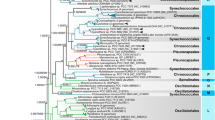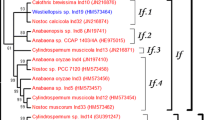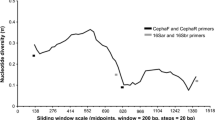Abstract
The success of some phylogenetic markers in cyanobacteria owes to the design of cyanobacteria-specific primers, but a few studies have directly investigated the evolution “behavior” of the loci. In this study, we performed a case study in Nostoc to evaluate rpoC1, hetR, rbcLX, and 16S rRNA–tRNAIle–tRNAAla-23S rRNA internal transcribed spacer (ITS) as phylogenetic markers. The results indicated that the gene trees of these loci are not congruent with the phylogeny based on 16S rRNA gene. The mechanisms contributing to the incongruence include randomized variation and recombination. As the results suggested, one should be careful to choose the molecular markers for phylogenetic reconstruction at the intrageneric level in cyanobacteria.

Similar content being viewed by others
References
Archie J (1989) A randomization test for phylogenetic information in systematic data. Syst Zool 38:239–252
Boyer S, Flechtner V, Johansen J (2001) Is the 16S–23S rRNA internal transcribed spacer region a good tool for use in molecular systematics and population genetics? A case study in cyanobacteria. Mol Biol Evol 18:1057–1069
Brocchieri L (2001) Phylogenetic inferences from Molecular sequences: Review and critique. Theor Popul Biol 59:27–40
Dodds W, Gudder D (1995) The ecology of Nostoc. J Phycol 32:2–18
Farris J, Kallersjo M, Kluge A et al (1994) Testing significance of incongruence. Cladistics 10:315–319
Gaitler N, Gouy M (1995) Inferring phylogenies from DNA sequences of unequal base compositions. Proc Natl Acad Sci U S A 92:11317–11321
Galtier N, Gouy M, Gautier C (1996) SeaView and Phylo Win, two graphic tools for sequence alignment and molecular phylogeny. Comput Applic Biosci 12:543–548
Gibbs M, Armstrong J, Gibbs A (2000) Sister-scanning: A Monte Carlo procedure for assessing signals in recombinant sequences. Bioinformatics 16:573–582
Gugger M, Lyra C, Henriksen P et al (2002) Phylogenetic comparison of the cyanobacterial genera Anabaena and Aphanizomenon. Int J Syst Evol Microbiol 52:1867–1880
Hillis D, Huelsenbeck J (1992) Signal, noise, and reliability in molecular phylogenetic analyses. J Hered 83:189–195
Janasson S, Wouters J, Bergman B et al (1999) Host specificity in the Richelia-diatom symbiosis showed by hetR gene sequence analysis. Environ Microbiol 1:431–438
Janson S, Graneli E (2002) Phylogenetic analyses of nitrogen-fixing cyanobacteria from the Baltic Sea show sequence anomalies in the phycocyanin operon. Int J Syst Evol Microbiol 52:1397–1404
Janson S, Matveyev A, Bergman B (1998) The presence and expression of hetR in the nonheterocystous cyanobacterium Symploca PCC 8002. FEMS Microbiol Lett 168:173–179
Komárek J, Anagnostidis K (1989) Modern approach to the classification system of Cyanophytes 4-Nostocales. Arch Hydrobiol 82(Suppl.):247–345
Kumar S, Tamura K, Nei M (2004) Mega3: Integrated software for molecular evolutionary genetics analysis and sequence alignment. 5:150–163
Kurland C (2000) Something for everyone. Horizontal gene transfer in evolution. EMBO Rep 1:92–95
Laamanen M, Forsstrom L, Sivonen K (2002) Diversity of Aphanizomenon flos-aquae (cyanobacterium) populations along a Baltic Sea salinity gradient. Appl Environ Microbiol 68:5296–5303
Lockhart P, Steel M, Hendy M et al (1994) Recovering evolutionary trees under a more realistic model of sequence evolution. Mol Biol Evol 11:605–612
Lorenz M, Wackernagel W (1994) Bacterial gene transfer by natural genetic transformation in the environment. Microbiol Rev 58:563–602
Lyra C, Laamanen M, Lehtimaki J et al (2005) Benthic cyanobacteria of the genus Nodularia are nontoxic, without gas vacuoles, able to glide and genetically more diverse than planktonic Nodularia. Int J Syst Evol Microbiol 55:555–568
Manen J, Falquet J (2002) The cpcB-cpcA locus as a tool for the genetic characterization of the genus Arthrospira (Cyanobacteria): Evidence for horizontal transfer. Int J Syst Evol Microbiol 52:861–867
Martin D, Rybicki E (2000) RDP: Detection for recombination amongst aligned sequences. Bioinformatics 16:562–563
Martin D, Willamson C, Posada D (2005) RDP2: Recombination detection and analysis from sequence alignments. Bioinformatics 21:260–262
Mes T, Stal L (2005) Variable selection pressures across lineages in Trichodesmim and related cyanobacteria based on the heterocyst differentiation protein gene hetR. Gene 346:163–171
Ochman H, Lawrence J, Groisman E (2000) Lateral gene transfer and the nature of bacterial innovation. Nature 405:299–304
Otsuka S, Suda S, Li R et al (1999) Phylogenetic relation between toxic and nontoxic strains of the genus Microcystis based on 16S to 23S internal transcribed spacer sequence. FEMS Microbiol Lett 172:15–21
Palenik B (1994) Cyanobacterial community structures as seen from RNA polymerase gene sequence analysis. Appl Environ Microbiol 60:3212–3219
Philippe H, Forterre P (1999) The rooting of the universal tree of life is not reliable. J Mol Evol 49:509–523
Posada D (2002) Evaluation of methods for detecting recombination from DNA sequences: Empirical data. Mol Biol Evol 19:708–717
Posada D, Crandall K (1998) Modeltest: Testing the model of DNA substitution. Bioinformatics 14:817–818
Posada D, Crandall K (2001) Performance of methods for detecting recombination from DNA sequences: Computer simulations. Proc Natl Acad Sci U S A 98:13757–13762
Rajaniemi P, Hrouzek P, Kastovska K et al (2005) Phylogeny and morphologic evaluation of the genera Anabaena, Aphanizomenon, Trichormus and Nostoc (Nostocales, Cyanobacteria). Int J Syst Evol Microbiol 51:505–512
Rantala A, Fewer D, Hisbergues M et al (2004) Phylogenetic evidence for the early evolution of microcystin synthesis. Proc Natl Acad Sci U S A 101:568–573
Rikkinen J, Oksanen I, Lohtander K (2002) Lichen guilds share related cyanobacterial symbionts. Science 297:357
Rippka R, Castenholz RW, Herdman M (2001) Subsection. In: Boone DR, Castenholz RW (eds) Bergey’s Manual of Systematic Bacteriology, vol 1. 2nd. New York, NY: Springer, pp 562–566 [Formerly Nostocales Castenholz (1989b) Sensu Rippka, Deruelles, Waterbury, Herdman and Stanier 1979]
Rocap G, Distel D, Waterbury J et al (2002) Resolution of Prochlorococcus and Synechococcus ecotypes by using 16S–23S ribosomal DNA internal transcribed spacer sequences. Appl Environ Microbiol 68:1180–1191
Rudi K, Skulberg O, Jakobsen K (1998) Evolution of cyanobacteria by exchange of genetic material among phyletically related strains. J Bacteriol 180:3453–3461
Salminen N, Carr J, Burke D et al (1996) Identification of break points in intergenotypic recombinants of HIV–1 by bootscanning. AIDS Res Hum Retrovir 11:1423–1425
Sawyer S (1999) GENECONV: A computer package for the statistical detection of gene conversion. Distributed by the author, Department of Mathematics, Washington University, St Louis, MO. Available at: http://www.math.wustl.edu/~sawyer
Shen P, Huang H (1986) Homologous recombination in Escherichia coli dependence on substrate length and homology. Genetics 112:441–457
Shimodaira H, Hasegawa W (1999) Multiple comparisons of log-likehoods with applications to phylogenetic inference. Mol Biol Evol 16:1114–1116
Smith J (1992) Analyzing the mosaic structure of genes. J Mol Evol 34:126–129
Svenning M, Eriksson T, Rasmussen U (2005) Phylogeny of symbiotic cyanobacteria within the genus Nostoc based on 16S rRNA sequence analyses. Arch Microbiol 183:19–26
Swofford D (2001) PAUP* 4.0: Phylogenetic analysis using parsimony (*and other methods). Sinauer, Sunderland, UK
Tanabe Y, Kaya K, Watanabe M (2004) Evidence for recombination in the microcystin synthetase (mcy) genes of toxic cyanobacteria Microcystis spp. J Mol Evol 58:633–641
Templeton A (1983) Phylogenetic inference from restriction endonuclease cleavage site maps with particular reference to the evolution of humans the apes. Evolution 37:221–244
Thompson J, Gibson T, Plewniak F et al (1997) The ClustalX windows interface: Flexible strategies for multiple sequence alignment aided by quality analysis tools. Nucleic Acids Res 24:4876–4882
Wilmotte A, Van der Auwera G, De Wachter R (1993) Structure of the 16S ribosomal RNA of the thermophilic cyanobacterium Chlorogloeopsis HTF (‘Mastigocladus laminosus HTF’) strain PCC7518, and phylogenetic analysis. FEBS Lett 317:96–100
Yang Z (1996) Among-site rate variation and its impact on phylogenetic analysis. Tree 11:367–372
Acknowledgments
This study was funded by the Natural Science project of Hubei Province (2004AB127), China. We thank Dr. Xudong Xu for kindly providing experimental materials for TA clone and Dr. Renhui Li for critically reading the manuscript and providing helpful comments.
Author information
Authors and Affiliations
Corresponding author
Rights and permissions
About this article
Cite this article
Han, D., Fan, Y. & Hu, Z. An Evaluation of Four Phylogenetic Markers in Nostoc: Implications for Cyanobacterial Phylogenetic Studies at the Intrageneric Level. Curr Microbiol 58, 170–176 (2009). https://doi.org/10.1007/s00284-008-9302-x
Received:
Accepted:
Published:
Issue Date:
DOI: https://doi.org/10.1007/s00284-008-9302-x




